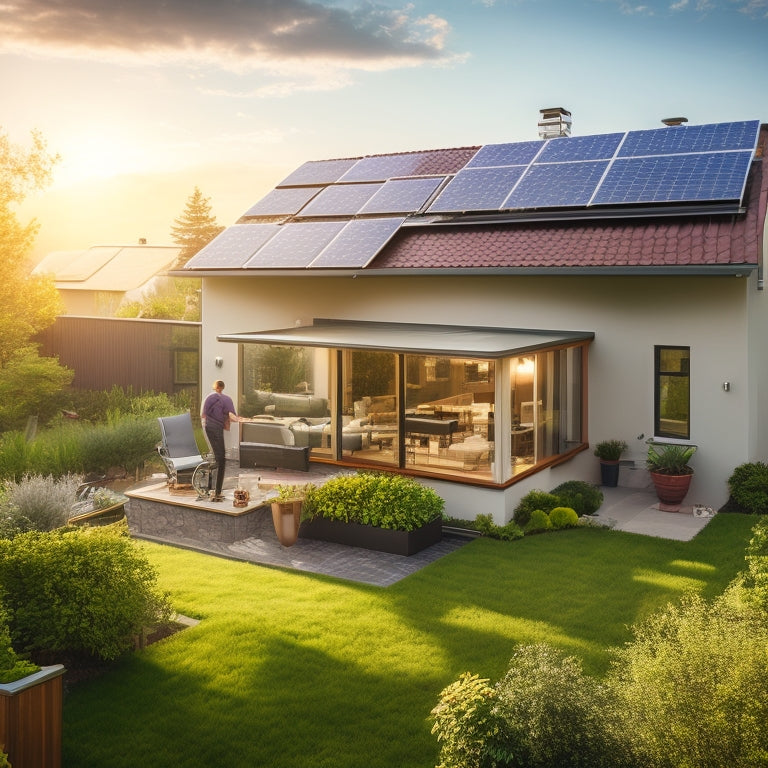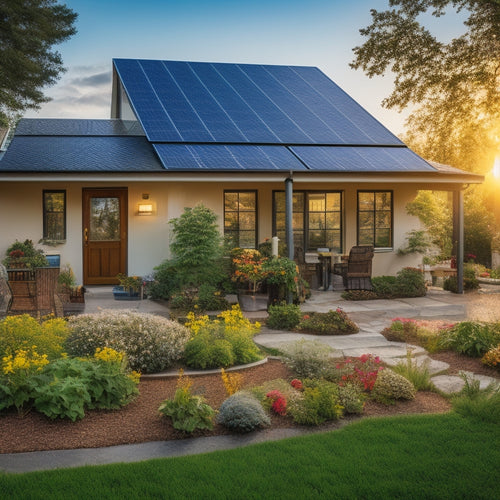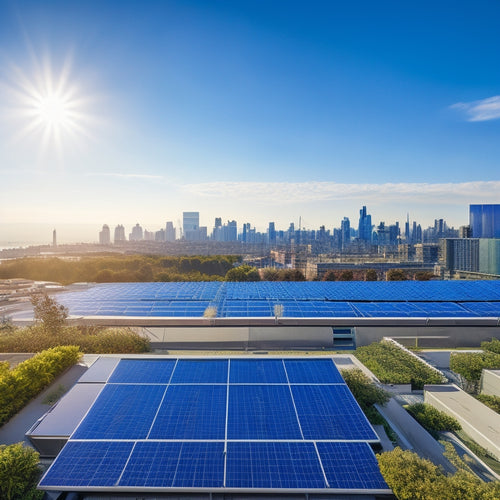
Design and Install Your Own Solar Panel System
Share
To design and install your own solar panel system, start by analyzing your home's electricity consumption and perform a detailed energy audit. Choose panels with high efficiency and quality inverters; guarantee all components are compatible. Plan your system layout, prioritizing areas with ideal sun exposure and minimal shading. Design a sturdy mounting structure, considering tilt angles and structural integrity. Proceed with meticulous wiring, securing connections with high-quality materials. Maximize your inverter setup to ensure efficiency, then connect DC input and AC output correctly. Regularly test and monitor your system for peak performance. Now, let's dive deeper into each phase.
Key Takeaways
- Conduct an energy audit to understand your home's electricity consumption and identify areas of wastage.
- Evaluate solar panel efficiency and inverter quality, ensuring kit compatibility and considering warranties.
- Plan the placement and orientation of panels to maximize sun exposure and minimize shading.
- Select appropriate mounting materials, assess tilt angles, and ensure structural integrity for roof or ground installations.
- Secure wiring connections, integrate the inverter correctly, and regularly test the system for peak performance.
Assess Your Energy Needs
https://www.youtube.com/watch?v=TJBGbufexEM
To accurately assess your energy needs, start by analyzing your home's electricity consumption over the past year using your utility bills. Review these bills meticulously to identify consumption patterns. Calculate your average monthly usage in kilowatt-hours (kWh), noting any seasonal fluctuations. This will help you determine the capacity required for your solar panel system.
Conduct an energy audit of your home. This involves evaluating the efficiency of your appliances, lighting, and insulation. Identify areas where energy is wasted and consider making improvements. Efficient energy use can reduce the size of the solar panel system you'll need, thereby saving costs.
Pay close attention to peak usage times. Understanding when your energy consumption spikes will allow you to size your system to handle these peaks more effectively. If your peak usage occurs in the evening, consider adding a battery storage solution.
Document these findings in a detailed report. This report should include graphs, charts, and tables that clearly illustrate your consumption patterns. This analytical approach ensures you have a precise understanding of your energy needs, empowering you to make informed decisions.
Choose the Right Kit
Selecting the appropriate solar panel kit involves evaluating factors such as panel efficiency, inverter quality, and system compatibility with your energy needs. Begin by scrutinizing the panel efficiency; higher efficiency panels will convert more sunlight into electricity, maximizing your energy yield.
Next, examine the inverter quality, as the inverter is vital in converting DC electricity from the panels into usable AC electricity. A high-quality inverter ensures system reliability and efficiency.
Kit compatibility is paramount. Confirm that the components of your chosen kit—panels, inverters, mounting hardware—are designed to work seamlessly together. Incompatible components can lead to inefficiencies and system failures. Check the specifications and consult with manufacturers or experts if necessary.
Warranty considerations are essential for long-term investment protection. Look for thorough warranties covering not only the panels but also inverters and other system components. A robust warranty reflects the manufacturer's confidence in their product and provides you with peace of mind.
Design Your System Layout
Begin by mapping out the ideal placement of your solar panels to maximize exposure to sunlight throughout the day. Conduct a thorough shading analysis to identify any potential obstructions that could enhance the system's efficiency. Use tools like solar pathfinders or online solar calculators to assess shading from trees, buildings, or other structures.
Next, determine the best panel orientation. In the Northern Hemisphere, orient your panels to the south for maximum sun exposure. Adjust the tilt angle based on your latitude to optimize seasonal performance. For instance, a latitude of 30 degrees would suggest a 30-degree tilt.
Here's a quick reference table to help you design your system layout:
| Latitude Range | Ideal Tilt Angle | Orientation |
|---|---|---|
| 0-15° | 10-15° | South |
| 16-30° | 16-30° | South |
| 31-45° | 31-45° | South |
| 46-60° | 46-60° | South |
| 61-75° | 61-75° | South |
Evaluate the array layout, considering roof space and structural integrity. Guarantee an unobstructed path for wiring and access to inverters and batteries. Plan your design meticulously to liberate yourself from traditional energy constraints and harness the power of the sun with precision and efficiency.
Select Installation Location
When selecting your solar panel installation location, prioritize areas with maximum sun exposure and minimal shading obstructions. Conduct a thorough shade analysis to identify potential sources of shade throughout the day—trees, chimneys, or nearby structures can significantly affect your system's efficiency. Use tools like solar pathfinders or smartphone apps to map out sun paths and shade patterns over different seasons.
Roof orientation is essential for maximizing solar energy harvest. In the Northern Hemisphere, a south-facing roof is ideal because it receives the most sunlight throughout the year. If your roof's orientation isn't ideal, you might consider ground-mounted systems or east-west facing arrays, though these options may reduce efficiency. Additionally, evaluate the roof's tilt angle; a pitch between 15 to 40 degrees generally works best for capturing solar energy.
Ensure the roof structure can support the weight of solar panels and withstand local weather conditions. Consider the impact of roof material—metal and composite shingle roofs are typically suitable, while slate or wood may require additional precautions.
Mounting and Racking
Mounting and racking systems are vital components that guarantee your solar panels are securely affixed to your chosen installation site while optimizing their angle for maximum energy capture. The right system guarantees roof compatibility and durability. For ground mounts, you'll need to take into account soil type and wind load to maintain structural integrity.
When selecting a mounting system, prioritize the materials. Aluminum and stainless steel are common for their corrosion resistance and strength. You'll also need to assess tilt angles, as they dictate how efficiently your panels capture sunlight.
Here's a quick comparison of mounting options:
| Type | Advantages |
|---|---|
| Roof Mounts | Saves space, lower costs |
| Ground Mounts | Easy access, better cooling |
| Pole Mounts | Adjustable angles, versatile |
Roof mounts are ideal if you want to utilize existing structures. Ensure your roof can support the additional weight and take into account potential shading issues. Ground mounts offer flexibility in panel orientation and ease of maintenance but require more land and a robust foundation system.
Wiring and Connections
When addressing wiring and connections, make sure you select the correct cable size to handle the system's current without overheating.
Secure all wiring connections using appropriate connectors to prevent energy loss and potential hazards.
Careful attention to these details will optimize system efficiency and safety.
Proper Cable Sizing
To guarantee peak efficiency and safety in your solar panel system, you must meticulously select the correct cable size for all wiring and connections. The right cable size ensures that your system can handle the current without overheating and minimizes voltage drops, which can affect performance. Begin by understanding ampacity ratings, which indicate the maximum current a cable can safely carry.
When selecting cables, consider:
-
Ampacity Ratings: Make sure the cable can handle the maximum current expected.
-
Voltage Drops: Minimize drops to maintain system efficiency.
-
Cable Length: Longer cables may require larger sizes to reduce resistance.
- Environmental Factors: Take into account temperature and exposure to elements, which affect cable performance.
Using undersized cables can lead to overheating, energy loss, and potential safety hazards. It's important to calculate the current your system will generate and select cables that match or exceed this capacity. Additionally, accounting for voltage drops is crucial; even small drops can have a significant impact on your system's output.
Take control of your energy independence by choosing the proper cable size, ensuring that your solar panel system operates safely and efficiently. This step not only protects your investment but also empowers you to harness solar power effectively.
Secure Wiring Connections
Securing wiring connections is crucial for guaranteeing the safe and efficient operation of your solar panel system. Start by selecting high-quality copper lugs, as they provide superior conductivity and corrosion resistance. Position them at the ends of your wires to ensure a steadfast connection.
Next, focus on wire crimping. Utilize a professional-grade crimping tool to compress the copper lugs onto the wire ends. This process ensures a secure, low-resistance connection capable of handling high current loads. Make sure the crimp is tight, but avoid over-crimping, which can damage the wire strands and compromise the connection.
After crimping, inspect each connection meticulously. Look for any loose strands or incomplete crimps, as these can lead to increased resistance and potential overheating. Employ a continuity tester to verify that each connection is solid and free of any interruptions.
Inverter Setup
When setting up your inverter, you'll need to first determine the best inverter type for your system—whether it's a string inverter, microinverter, or hybrid inverter.
Next, make sure that your wiring and connections meet both the system specifications and local code requirements.
Properly integrating the inverter will maximize your system's efficiency and longevity.
Choosing Inverter Type
Selecting the appropriate inverter type is essential for optimizing the efficiency and reliability of your solar panel system. Inverters convert DC electricity generated by your panels into AC electricity used by most household appliances. Your choice impacts inverter efficiency and inverter lifespan, two critical factors for a high-performing system.
Consider these common inverter types:
-
String Inverters: Typically used in residential installations, they offer a balance between cost and efficiency. However, they're less effective in shaded areas.
-
Microinverters: Installed on each panel, they optimize each panel's output independently, enhancing performance in varied conditions. They often have a longer lifespan but at a higher cost.
-
Power Optimizers: These work with string inverters to enhance panel-level performance, combining the best of both worlds—cost-effectiveness and higher efficiency.
- Hybrid Inverters: Ideal for systems including battery storage, they provide flexibility and improve energy management, important for maximizing self-consumption.
Each inverter type comes with its own set of advantages and trade-offs. Your decision should align with your specific needs, local environmental conditions, and budget.
Wiring and Connections
Prior to starting the inverter setup, make sure you have a detailed wiring diagram that outlines all essential connections and cable specifications. Begin by adhering to safety protocols; disconnect any power sources to avoid electrical hazards. Select a favorable location for the inverter, ensuring it's dry, well-ventilated, and easily accessible for maintenance.
Next, focus on grounding techniques. Proper grounding prevents electrical faults and ensures system stability. Connect the inverter's grounding terminal to a grounding rod using a copper wire, following local electrical codes. This step is vital for mitigating voltage spikes and ensuring personal safety.
Proceed with connecting the DC input from your solar panels to the inverter. Use MC4 connectors for secure and weatherproof connections. Verify polarity to prevent reverse current flow, which can damage the system. Then, connect the AC output of the inverter to your home's electrical panel. Use appropriately rated circuit breakers to safeguard against overloads and short circuits.
Double-check all connections for tightness and accuracy. Activate the system and monitor the inverter's display for operational status and potential error codes.
Following these steps precisely not only ensures a successful installation but also frees you from dependency on traditional energy sources.
Testing and Monitoring
To guarantee peak performance, regularly testing and monitoring your solar panel system is essential for identifying any inefficiencies or potential issues. By focusing on performance metrics and conducting thorough system diagnostics, you can make sure your system operates at its best capacity.
First, track the energy production daily. Use monitoring software to log data and create performance benchmarks. This helps you quickly spot any deviations.
Next, perform voltage and current checks. Measure the output of each panel and compare it to the manufacturer's specifications to ensure consistency.
Regularly inspect physical components. Look for signs of wear, such as discoloration, cracks, or loose connections that could impact performance.
Frequently Asked Questions
What Are the Typical Maintenance Requirements for a Solar Panel System?
Think of your solar panel system like a well-oiled machine. You'll need a cleaning schedule to remove debris and dirt, plus regular inverter maintenance. This guarantees peak performance and uninterrupted energy independence.
How Do Weather Conditions Affect Solar Panel Efficiency?
Temperature fluctuations and cloud coverage greatly impact solar panel efficiency. High temperatures can reduce output, while cloud coverage lowers sunlight absorption. Optimize your system's performance by considering these factors in your installation and maintenance strategies.
What Is the Average Lifespan of a Solar Panel System?
The average lifespan of a solar panel system is 25-30 years. During this warranty period, expect a degradation rate of about 0.5-1% annually. You'll enjoy sustained energy production and long-term financial freedom from energy costs.
Are There Any Government Incentives or Rebates for Installing Solar Panels?
Absolutely, there are government incentives. Federal tax credits and various state incentives are available, making your solar investment shine like a beacon. These initiatives can dramatically reduce installation costs, propelling you towards energy independence and liberation.
Can a Solar Panel System Increase the Value of My Property?
Yes, a solar panel system can increase your property's value. During property appraisal, energy savings are factored in, making your property more attractive to buyers seeking long-term cost efficiency and sustainability, enhancing overall market appeal.
Related Posts
-

Evaluating Solar Power Options for Businesses
Evaluating solar power options for your business can greatly reduce energy costs and enhance sustainability. Start by...
-

How to Achieve Energy Independence at Home
To achieve energy independence at home, start by investing in renewable energy sources like solar panels, wind turbin...
-

Business Solar Investments for Cost-Effective Sustainability
Investing in solar energy is a smart move for your business, providing a solid foundation for cost-effective sustaina...


